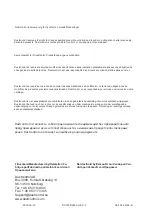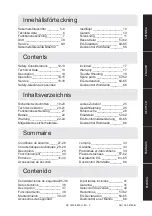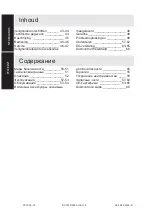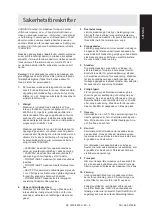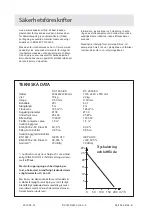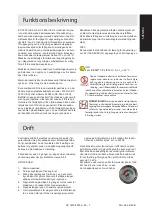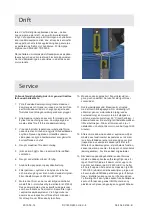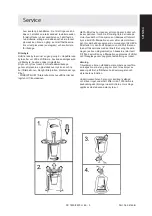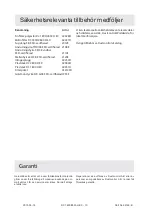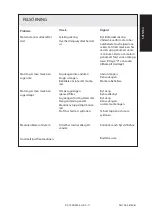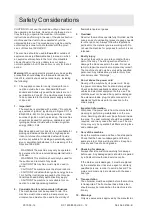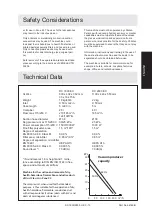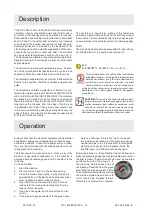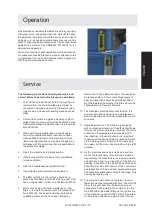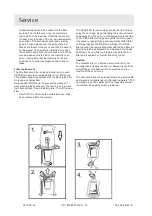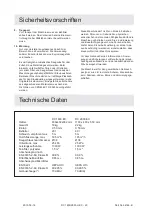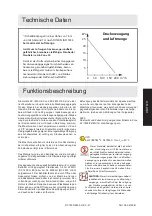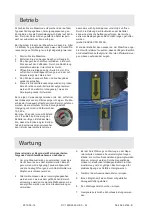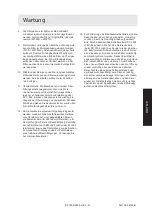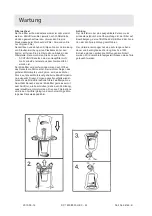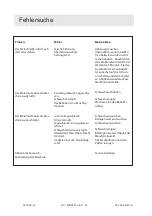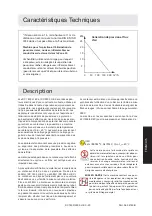
DC 1800/2800 H EX - 14
Part No 94169-B
2015-09-16
Description
Operation
TThe DC 1800 H EX and DC 2800 H EX are electrically
operated, robustly constructed dust extractors for use in
conjunction with dust-generating operations in industry.
Dust extractors are suitable for the collection of
fl
ammable
dust in Zone 22. Industrial dust extractors are intended
to be used for the suction and removal of dust deposits.
Explosion protection is provided by the insulation of the
electrical parts and the potential equalisation of the com-
ponents that come into contact with dust. The machine
can be used at temperatures b10 and +40 °C.
The machines are suitable for general cleaning operations.
Regular cleaning of the workplace is important to prevent
dust explosions.
The extractors operate with negative pressure. Separa-
tion of the coarse particles takes place in a cyclone, and
separation of the
fi
ne dust takes place in the
fi
lter unit.
The material is separated into a container that is attached
directly to the cyclone. The
fi
lter is cleaned using reverse
pulse.
The extracted and
fi
ltered material is collected in a con-
tainer with a plastic sack insert, Part No. 42951H (DC 1800
H EX) or Part No. 42384H (DC 2800 H EX). The container
can easily be removed from the machine by opening the
fasteners, making it easy to dispose of the material. Care-
fully remove the full sack from the edge of the bin and
immediately seal it tight. Then place a new plastic sack
in the bin, and carefully pass the opening back over the
edge of the bin, ensuring that no damage is caused, and
such that no folds are visible.
The container is secured by means of the fasteners,
whereby a clamp must be placed on the earthing strap of
the machine. This is ensured by aligning the opposing red
arrow markings. (See also diagram on the following page).
ATEX
The machine and accessories are suitable for use in Zone
22 (1999/92/EC) for the suction and removal of:
II 3D
Ex tc IIIB T850 C Dc IP54 X, 10<= t
a
<=40
o
C
This Standard covers the safety of dust extractors
with electric motors, including dust separators and
back-pack vacuums, used for wet extraction, dry
extraction, or wet-and-dry extraction, supplied
for commercial use indoors and for outdoor use
with and without accessories, in order to collect com-
bustible dust in an atmosphere (Zone 22) designated
as explosive.
CAUTION!
This machine contains hazardous dust.
Emptying and any maintenance operations, includ-
ing the removal of dust collection containers, must
only be carried out by specialist personnel, who
must wear the appropriate protective equipment. Do
not operate without the complete fi ltration system.
Always check that the electrical equipment and potential
equalisation cables are undamaged, and that all acces-
sories are antistatic. Connect to a power source outside
the zone in accordance with the voltage speci
fi
ed on the
rating plate of the machine.
The
fi
lter should be cleaned once or twice a day if the
machine is operated continuously or, if the machine is
equipped with a pressure gauge and the needle is in the
red zone.
To clean the
fi
lter:
1. Start the machine.
2. Disconnect the hose from the suction casing.
3. Close the suction hose tightly, e.g. by pressing it
against the
fl
oor. Closing the hose produces maxi-
mum negative pressure in the machine.
4. Open the door on the side 3 to 6 times. The air
rushes into the machine and cleans the
fi
lter by
means of reverse pulse.
5. Open the hose again, and reconnect the suction
nozzle.
6. If the pressure gauge needle is in the green zone,
work can continue. If it is in the red zone, repeat
the reverse pulse cleaning. If the presusure gauge
needle remains in the red zone after reverse pulse
cleaning has been performed several times, the
fi
ne
fi
lter (part no. 42398) should be changed.
Some operations (i.e. those that that restrict air
fl
ow) can
make the pressure gauge show a high reading, even when
the
fi
lter is clean. The machine should never be operated
permanently when the gauge is in
the red zone, as this poses a risk of
overheating. Transition from the green
area to the red area occurs at 1.5 kPa.
The container underneath the cyclone
should be emptied when about 2/3
full or max 20 kg. Release the two
fasteners and remove the container.


